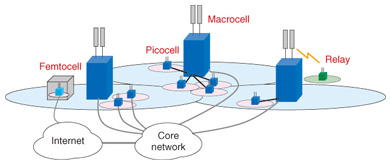 |
|||||||||||||||||||||||||||||
|
|
|||||||||||||||||||||||||||||
|
Global Standardization Activities Vol. 10, No. 1, pp. 48–52, Jan. 2012. https://doi.org/10.53829/ntr201201gls Overview and Standardization Trends of LTE-AdvancedAbstractThis article explains the features of and standardization schedule for LTE-Advanced, which has been approved by ITU-R (International Telecommunication Union, Radio Communication Sector) as one of the IMT-Advanced systems (IMT: International Mobile Telecommunication).
1. IntroductionNTT DOCOMO launched Xi™* (read “crossy”), Japan’s first wireless connectivity service based on the extra-high-speed technology, Long Term Evolution (LTE), on December 24, 2010 to increase the data rate, sophistication, and economy of our radio network. It is based on the LTE Release 8 specifications (hereinafter referred to as LTE Rel. 8) [1], for which standardization was completed by 3GPP (3rd Generation Partnership Project) in the spring of 2009. LTE Rel. 8 adopts various high-level radio interface technologies such as orthogonal multi-access, frequency-domain scheduling, and multiple-input multiple-output (MIMO) and provides even higher system capacity and throughput for cell edge users than High Speed Packet Access (HSPA). It also significantly reduces transmission and connection delays, resulting in major improvements in system performance [2]. NTT DOCOMO is playing a central role in advancing the LTE standardization in 3GPP, from proposing the basic concepts to completing the specifications. It is also supporting the standardization of LTE Rel. 9, which will further increase the sophistication of LTE, enabling the economical introduction of many different services and meeting the demands of LTE users in the future. LTE Rel. 9, which was completed in March 2010, provides various new functions including functional enhancement of HeNB (Home eNodeB or LTE femtocell [3]), extensions to network self-optimization, location services, and multimedia broadcast and multicast services (MBMS) [4]. NTT DOCOMO is also promoting the standardization of LTE-Advanced (LTE Rel. 10 and beyond), which will further increase the system performance of radio access networks. This is in consideration of the need to respond quickly to the explosive growth of data traffic caused by new devices such as smartphones and tablet computers together with social network services, web browsing, video streaming, and so on. NTT DOCOMO acted as rapporteur for the LTE-Advanced Study Item [5], which was approved in 3GPP in March 2008, and detailed specifications for LTE Rel. 10 were completed in June 2011. In addition to achieving major system performance increases over LTE Rel. 8, maintaining backward compatibility with LTE Rel. 8 is an important requirement of LTE-Advanced to enable smooth development of the system [6]. On the other hand, standardization of IMT-Advanced is progressing in ITU-R (International Telecommunications Union, Radio Communications Sector) as the successor to the International Mobile Telecommunications 2000 (IMT-2000) system, and LTE-Advanced is also a radio interface candidate for this new system. Because of this, it is very important for LTE-Advanced that the minimum requirements for IMT-Advanced are attained within the IMT-Advanced standardization schedule.
2. Standardization scheduleThe schedules for standardization of IMT-Advanced in ITU-R and LTE-Advanced in 3GPP are shown in Fig. 1. At ITU-R, new frequency bands for IMT were identified at the World Radiocommunication Conference 2007 (WRC-07) held in November 2007, and a circular letter soliciting radio interface proposals for IMT-Advanced was issued in March 2008 [7], [8]. In the same year, the requirements and evaluation conditions for IMT-Advanced were specified [9], [10], and by the end of the proposal submission period in October 2009, two proposals, based on LTE-Advanced and IEEE802.16m, respectively, were received. After that, external evaluations by evaluation groups registered with ITU-R began, and recommendations for the radio interface specifications are expected to be completed at the beginning of 2012, after final agreement on IMT-Advanced has been reached.
At 3GPP, a Study Item for the LTE-Advanced radio interface was started in March 2008 [5] prompted by the issue of ITU-R’s circular letter, and the requirements and evaluation conditions for LTE-Advanced were specified. Then, technical study of the LTE-Advanced radio interface proceeded, and a proposal for LTE-Advanced was submitted to ITU-R in October 2009 [11]. Doing so showed that all of the requirements for IMT-Advanced were satisfied according to 3GPP’s self-evaluation results. After the evaluation results had been reviewed by an external evaluation group registered with ITU-R, LTE-Advanced was approved as one of the IMT-Advanced systems by ITU-R working party 5D in October 2010. A Work Item to draft the detailed specifications for the LTE-Advanced radio interface was started in December 2009 and the technical specifications were completed in June 2011. 3. Requirements for LTE-Advanced in 3GPPThe requirements for LTE-Advanced are given in [6]. The following general requirements for LTE-Advanced were agreed upon. First, LTE-Advanced will be an evolution of LTE Rel. 8. Hence, distinctive performance gains from LTE Rel. 8 are required. Moreover, LTE-Advanced will satisfy all of the relevant requirements for LTE Rel. 8 [12]. Second, full backward compatibility with LTE Rel. 8 is required in LTE-Advanced. Thus, LTE-Advanced user equipment must be able to access LTE Rel. 8 networks, and LTE-Advanced networks must be able to support LTE Rel. 8 user equipment. Third, LTE-Advanced shall meet or exceed the IMT-Advanced requirements within the ITU-R time plan. The major performance requirements are listed in Table 1.
4. Major radio interface technologies for LTE-AdvancedTo satisfy the requirements for LTE-Advanced, improvements to the radio interface technologies were studied, with LTE Rel. 8 as the base. These are described below. 4.1 Carrier aggregationLTE Rel. 8 supports bandwidths up to 20 MHz, but one goal of LTE-Advanced is to support peak data rates of up to 1 Gbit/s on the downlink and 500 Mbit/s on the uplink, so wider bandwidths are needed. On the other hand, LTE-Advanced must also maintain backward compatibility with LTE Rel. 8. Accordingly, wider bandwidths are supported by combining multiple frequency blocks of bandwidth supported by LTE Rel. 8, called the component carrier, as shown in Fig. 2.
4.2 MIMO enhancementWith LTE Rel. 8, MIMO multiplexing of up to four layers is supported on the downlink, but MIMO multiplexing is not supported on the uplink. By contrast, LTE-Advanced supports single-user MIMO multiplexing with up to eight layers on the downlink and four layers on the uplink in order to satisfy the peak spectral efficiency requirements of 30 bit/s/Hz on the downlink and 15 bit/s/Hz on the uplink. Multi-user MIMO has also been improved in order to increase system capacity. For Rel. 11, we are also studying the introduction of coordinated multipoint transmission/reception (CoMP), which coordinates communication among multiple cells in order to improve throughput for cell edge users in particular, as shown in Fig. 3.
4.3 Interference coordination in heterogeneous networksAnother important requirement for LTE-Advanced is to reduce the cost of the radio access network. The deployment scenario for a heterogeneous network, which deploys small cells of various different types such as picocells and femtocells in the macrocell’s area to increase the capacity in high traffic areas, is shown in Fig. 4. To further increase the system capacity and throughput for cell edge users in the area, interference coordination between the macrocell and the picocells is specified.
4.4 Relay networkAnother approach to reducing the cost of the radio access network is to reduce the cost of the backhaul potion of the network. Radio relay transmission for the backhaul is being introduced as a low-cost means of expanding coverage in environments where wired transmission is particularly expensive, as shown in Fig. 5.
References
|
|||||||||||||||||||||||||||||
















